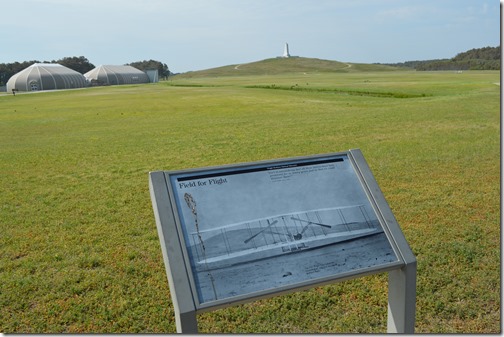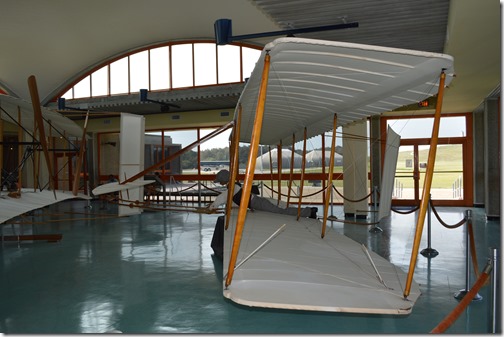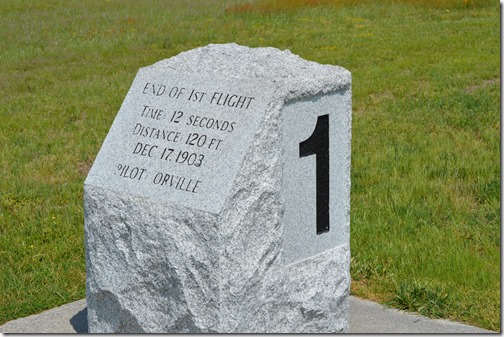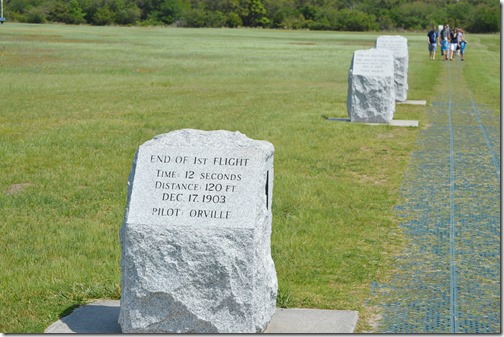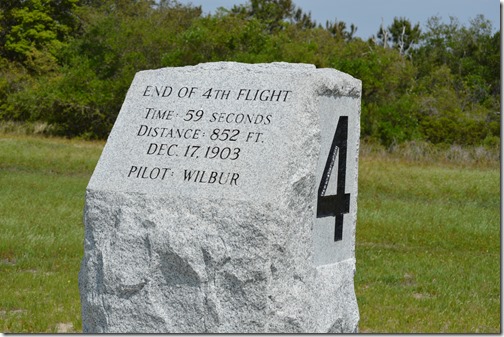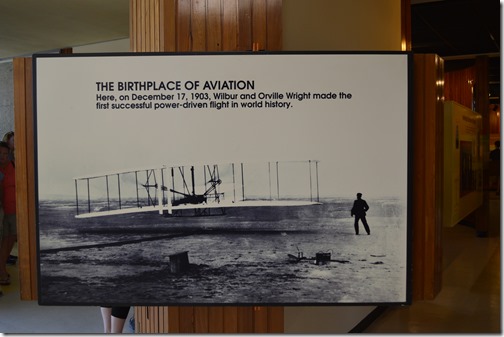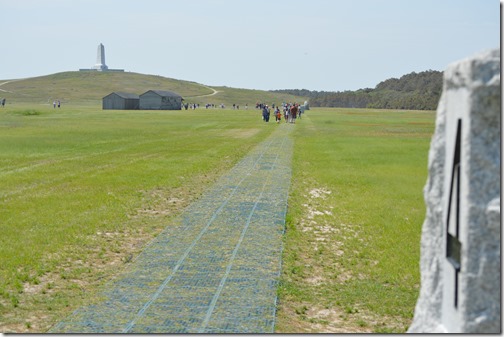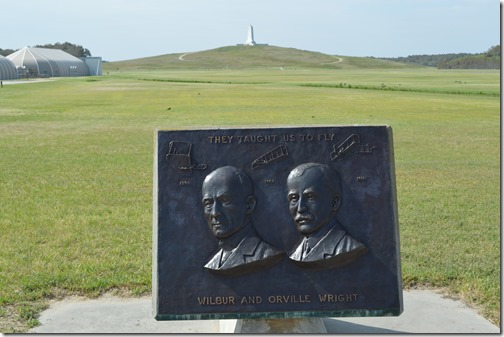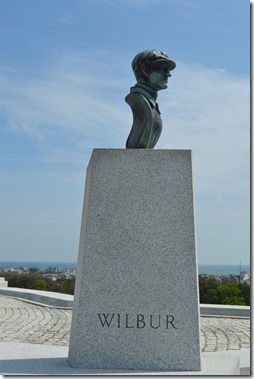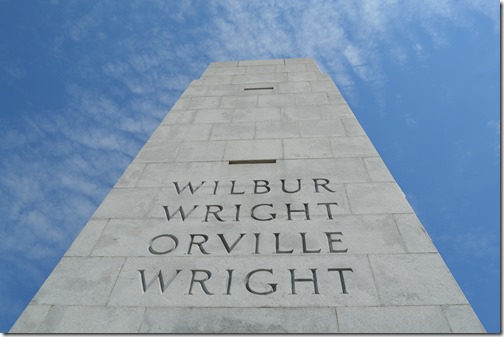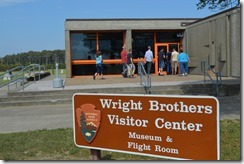My first surprise was learning the Wright Brothers National Memorial is not located in Kitty Hawk, North Carolina. The town of Kitty Hawk, North Carolina is the place name I have associated with the Wright Brothers first motor powered flight from my early days of grade school history and biographies, but the town of Kill Devil Hills was incorporated in 1953 and is the location of the Wright Brothers National Memorial today. The Wright Brothers aviation experiments took place in expansive and wind swept barren sand dunes of the northern Outer Banks, North Carolina. The high sand dune used as a launching point for the Wright Brothers glider aviation experiments is located in the town of Kill Devil Hills, about five miles south of Kitty Hawk. Kitty Hawk sounds dreamier, doesn’t it.
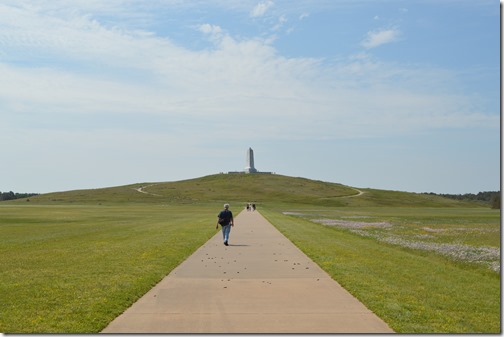 Wright Brothers Memorial on Kill Devil Hill that was a sand dune hill in 1903 surrounded by mostly barren sand dunes for miles around. The sand dune in 1903 was closer to the location where I am standing taking the photo above. The dune shifted south over the following two decades at a time when there was little vegetation to hold the dune in place from the natural force of winds. Extensive landscaping with grass cover and pine forest has covered over the shifting dunes of Kill Devil Hills.
Wright Brothers Memorial on Kill Devil Hill that was a sand dune hill in 1903 surrounded by mostly barren sand dunes for miles around. The sand dune in 1903 was closer to the location where I am standing taking the photo above. The dune shifted south over the following two decades at a time when there was little vegetation to hold the dune in place from the natural force of winds. Extensive landscaping with grass cover and pine forest has covered over the shifting dunes of Kill Devil Hills.
Field for Flight sign shows the barren landscape of 1903 in this location specifically chosen by the Wright Brothers for their aviation experiments after consulting the United States Weather Bureau for suitable locations with frequent occurrences of steady and sustained winds.
The Wright brothers were careful in setting their environmental criteria for conducting their gliding experiments in 1900; they needed reasonably brisk, steady winds, open areas free from obstructions, elevations from which to launch their glider, and soft terrain upon which to land. Records from the United States Weather Bureau in Washington D.C. revealed a likely location near Kitty Hawk, North Carolina. Kitty Hawk Weather Station manager, J.J. Dosher, replied to a Wright brothers’ inquiry, answering that the sandy beaches were wide and clear of obstructions and the winds blew steady from the north and northeast in September and October. Dosher prompted Captain William Tate, a county commissioner, postmaster, and leading citizen of Kitty Hawk, to write a letter to the Wrights: “You could for instance get a stretch of sandy land one-mile by five with a bare hill in center 80 feet high not a tree or bush anywhere to break the evenness of the wind current. . . . I assure you, you will find a hospitable people when you come among us.” Kitty Hawk – A Likely Location for Flying Wright Brothers National Memorial – National Park Service
The remote isolation of Kitty Hawk, North Carolina was a desirable spot for the Wright Brothers experiments at a time when there was a race to be the first person to fly a controllable, motor-powered airplane. Wilbur and Orville Wright Wilbur, born in 1867, was four years older than Orville, born in 1871. They had two older brothers in the family and one younger sister who was 15 when their mother died of tuberculosis in 1889. Their father worked in the Church of the United Brethren in Christ and the family relocated from Indiana to Dayton, Ohio in 1885 when the two younger boys were teenagers. Susan Catherine Koerner Wright was a mother with mechanical aptitude having grown up on an Indiana farm where she worked with tools in her father’s carriage repair shop. As a mother, she built home appliances and toys for her children. Milton Wright had a job in the church printing establishment of Dayton, Ohio.
Orville was a natural inventor who liked to dismantle and rebuild machines. He took advance prep science classes in high school rather than the prescribed curriculum that would allow him to graduate. Wilbur Wright lost his front teeth in an ice hockey injury soon after the family moved to Dayton and he became socially withdrawn. In 1888 Orville started a printing press business as a teenager and was joined by Wilbur in producing newspapers, pamphlets and catalogs. Orville designed a larger printing press with Wilbur to allow bigger print jobs. The Wright Brothers maintained their print business until 1899.
The Wright Brothers opened the Wright Cycle Company in 1893 to capitalize on the craze of the modern bicycle developed in England in 1887. Over one million bicycles a year were built and sold across the USA in the 1890s. Their income from their businesses allowed them to develop and finance their interest in aviation. The brothers manufactured their own bicycle line in Dayton and the income from their bicycle business allowed them to experiment with gliders and aviation in the late 1890s. Their first experimental aircraft were designed in their Dayton bicycle factory. The Wright Cycle Company and Wright Brothers house was purchased by Henry Ford and moved to his Greenfield Village museum in Dearborn, Michigan in 1937.
1899 and the pursuit of aeronautics education
May 31, 1899 Wilbur Wright wrote the Smithsonian Institution to ask for materials on the science of aeronautics. The Wright Brothers cited the death of German glider aviation pioneer, Otto Lilienthal 1848–1896, as their inspiration for serious pursuit of aeronautics. Lilienthal had made nearly 2,000 flights in 16 glider designs between 1891 and 1896 when he died in a glider crash. Wing-warping was the Wright Brothers breakthrough for lateral control of an aircraft. Wilbur designed a kite in 1899 with this concept and the successful trials of the kite encouraged the brothers to pursue full scale glider trials. The Wright Brothers glider experiments in the fall of 1900 brought the brothers to the sand dunes of Kitty Hawk in the Outer Banks of North Carolina. Their experiments lasted for two months in the fall and then they returned home to Dayton and improved the glider design based on their test results. The brothers built their own wind tunnel and instruments to measure the effect of over 200 different wing types. Their wind tunnel data allowed them to more accurately determine the mathematics of lift and drag on wing types than the prevailing aeronautical research data being used from others’ aeronautical engineering experiments. The 1902 glider prototype developed from their wind tunnel data. Their time testing the glider in the fall of 1902 at Kill Devil Hills, North Carolina revealed a promising design. During September and October, Wilbur and Orville made nearly 1,000 glides, some with distances over 500 feet.
1903 Wright Flyer
Replica of 1903 Wright Flyer at Wright Brothers National Memorial visitor center, Kill Devil Hills, North Carolina. In the fall of 1903, the Wright Brothers returned to Kitty Hawk with a motorized version of their 1902 glider.
Allowing 200 pounds for the propulsion system, they estimated that the aircraft with pilot would weigh 625 pounds. Based on this estimate, they calculated power, thrust, and speed requirements and concluded they needed an 8-horsepower engine generating 90 pounds of thrust to achieve a minimum airspeed of 23 miles per hour. Smithsonian National Air and Space Museum
The Wright Brothers had been at Kitty Hawk for three months in 1903 working on their test flights and airplane design before a successful flight.
Finally, on December 17, 1903 the Wright Flyer was launched from a wooden track and flew 12 seconds in the air over a distance of 120 feet. Orville had won the coin toss for the test flight and became the first human to successfully fly a motorized airplane.
Wilbur Wright made the second successful flight that day.
Wilbur Wright flew about 12 seconds over a distance of 175 feet in the second flight of December 17, 1903.
Markers seen here mark the distance of the first three airplane flights in the Wright Flyer on December 17, 1903. The third flight was piloted by Orville Wright who flew about 15 seconds over a distance of 200 feet.
The fourth and final flight of December 17, 1903 was piloted by Wilbur who managed to control the aircraft for a flight of 852-feet while in the air 59 seconds.
The Wright Flyer aircraft was damaged after the fourth flight when a gust of wind flipped the flyer. History was already made and there were no more flights that year.
One of the interesting tales of the museum center presenter about the Wright Brothers experiments is the local assistant who had never before taken a photograph managed to capture the Wright Flyer in flight that December 1903 day.
Standing at the flight marker #4 looking across the field to the replicas of the Wright Brothers camp shed and aircraft shed.
Wilbur and Orville Wright. The Wright Brothers had flown a motor-powered airplane in a straight-line. This was an achievement, but not a practical airplane. Their work continued in Dayton, Ohio and their 1904 Flyer was able to make a circular flight that lasted 1 minute, 36 seconds and covered 4,080 feet. The 1905 flyer was their breakthrough for a practical airplane with their third motor powered aircraft. On October 5, 1905, Wilbur made a flight where he circled the field outside of Dayton 30 times in 39 minutes for a flight distance of 24.5 miles. For the next two years the Wright Brothers published their flight experiments in science journals, but did not fly their aircraft. They were awaiting patents in the USA and Europe before launching an aircraft company.
In 1908, Wilbur Wright took their Flyer to Europe where he made more than 200 flights to quell disbelievers that powered flight had been achieved in America. The Wright Brothers created the Wright Company in 1910 to market their Flyer. Wilbur died soon after from typhoid fever at the age of 45 in 1912. Orville sold the company in 1915 and soon retired from flying.
The age of flight grew rapidly with technological improvements to aircraft during World War I. “In commemoration of the conquest of the air by the brothers Wilbur and Orville Wright. Conceived by genius. Achieved by dauntless resolution and unconquerable faith.” 1932 Inscription on the Wright memorial at Kitty Hawk.
Wright Brothers National Memorial, Kill Devil Hills, North Carolina
*****
Ric Garrido of Monterey, California is writer and owner of Loyalty Traveler.
Loyalty Traveler shares news and views on hotels, hotel loyalty programs and vacation destinations for frequent guests. Check out current hotel loyalty program offers across all the major chains in Loyalty Traveler’s monthly hotel promotions guide.
Follow Loyalty Traveler on Twitter and Facebook and RSS feed.


